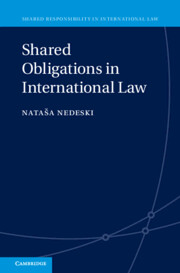Book contents
- Shared Obligations in International Law
- Shared Responsibility in International Law
- Shared Obligations in International Law
- Copyright page
- Contents
- Figures
- Table
- Acknowledgements
- Abbreviations
- 1 Setting the Scene
- 2 The Concept of Shared Obligations in International Law
- 3 The Distinction between Bilateral and Multilateral Legal Relations in the International Law of Obligations
- 4 Indivisible and Divisible Shared Obligations in International Law
- 5 Sharing International Obligations and the Determination of Shared Responsibility
- 6 Claiming Cessation and Reparation for Breaches of Shared Obligations
- 7 Conclusion
- Index
2 - The Concept of Shared Obligations in International Law
Published online by Cambridge University Press: 07 July 2022
- Shared Obligations in International Law
- Shared Responsibility in International Law
- Shared Obligations in International Law
- Copyright page
- Contents
- Figures
- Table
- Acknowledgements
- Abbreviations
- 1 Setting the Scene
- 2 The Concept of Shared Obligations in International Law
- 3 The Distinction between Bilateral and Multilateral Legal Relations in the International Law of Obligations
- 4 Indivisible and Divisible Shared Obligations in International Law
- 5 Sharing International Obligations and the Determination of Shared Responsibility
- 6 Claiming Cessation and Reparation for Breaches of Shared Obligations
- 7 Conclusion
- Index
Summary
This chapter sets out to capture the practical phenomenon of sharing international obligations by developing a concept of shared obligations. In the stipulation of this concept, the chapter draws from and engages with various scenarios in practice that involve obligations incumbent on multiple states or international organizations, including those obligations that have been designated as ‘shared’, ‘joint’ or ‘collective’ in legal literature. By expanding on three elements that characterize a shared obligation, it is argued that the main characteristic that distinguishes obligations that are shared from obligations that are not shared is the existence of a connection between the bearers of an obligation in the performance of that obligation. It is this particular relationship between the bearers of a shared obligation that gives rise to questions regarding performance and international responsibility: who is bound to do what and, subsequently, who can be held responsible for what in case of a breach? All in all, qualifying a particular obligation as ‘shared’ brings such questions to the forefront, and thereby constitutes the first step towards addressing them.
Keywords
- Type
- Chapter
- Information
- Shared Obligations in International Law , pp. 24 - 53Publisher: Cambridge University PressPrint publication year: 2022



